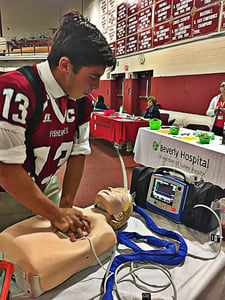Eric Smith, Fire Chief
8 School St.
Gloucester, MA 01930
For Immediate Release
Thursday, Oct. 5, 2017
Contact: John Guilfoil
Phone: 617-993-0003
Email: john@jgpr.net
Gloucester Firefighters Offer Lifesaving Lessons at Gloucester High School Health Resource Fair

GLOUCESTER — Chief Eric Smith is pleased to report that members of the Gloucester Fire Department visited Gloucester High School’s Health Resource Fair last week, where they were one of more than two dozen health-related organizations that connected with students about the critical work they do.
Gloucester Firefighter and Paramedic Patrick Legro represented the department at the fair on Sept. 29 at the GHS Field House. He introduced students to the broad range of technologies he and his colleagues use every day when responding to medical emergencies and showed them some of the advanced lifesaving techniques Gloucester firefighters employ when providing initial aid to patients in need.
Heart Disease and Acute Coronary Syndrome are the leading cause of death in the United States, and the sudden cardiac arrest caused by those conditions is one of the biggest challenges EMS providers face on a regular basis. Legro’s said his most important job at the Resource Fair was to instill in the more than 100 students he met just how important it is for bystanders to take immediate and decisive action in order to help increase a heart attack victim’s chances for survival.
“Sudden cardiac arrest calls are some of the most challenging ones we respond to because of how little time patients have to survive once their symptoms begin,” Firefighter Legro said. “By sharing CPR techniques with citizens, it empowers them to take immediate lifesaving action and gives victims a far better chance at survival. I think students really grasped the importance of reacting quickly, which could ultimately help save lives.”
Legro brought the department’s CPR mannequin and one of its new Zoll X-Series cardiac monitors, which gives first responders the ability to track how well they are doing when performing CPR on a cardiac arrest victim. The device sits on the patients chest and directly under the first aid provider’s hands during CPR and helps them to make necessary adjustments immediately in order to best help patients.
“Nothing can replace the invaluable support bystanders can provide by immediately recognizing a cardiac event and beginning to administer aid,” Chief Smith said. “The Resource Fair was a great opportunity for us to get the word out about the important role bystanders play in helping people survive a cardiac event, and I am glad that we were able to participate.”
Students were able to perform CPR on the fire department’s mannequin and get real time feedback from the cardiac monitor, which they could then rely upon should they ever find themselves in a position to administer aid in a real-life scenario.
The American Heart Association recommends starting chest compressions immediately once a person begins suffering symptoms of a heart attack, calling 911 and continuing to provide CPR until help arrives. Chest compressions should be administered on adults at a depth of two inches and at a rate of 100-120 compressions per minute.
###
Discover more from John Guilfoil Public Relations
Subscribe to get the latest posts sent to your email.
